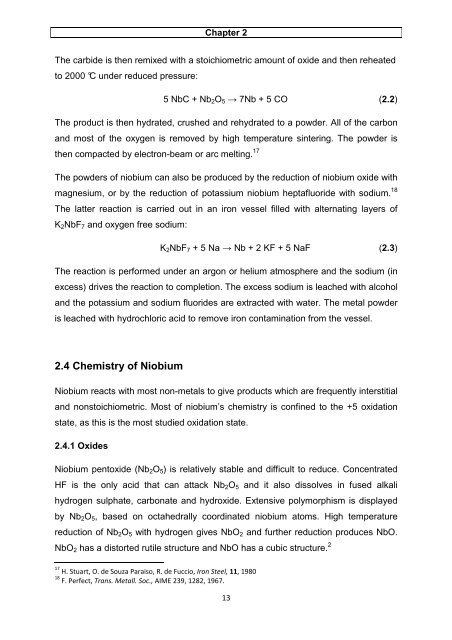A solution and solid state study of niobium complexes University of ...
A solution and solid state study of niobium complexes University of ...
A solution and solid state study of niobium complexes University of ...
Create successful ePaper yourself
Turn your PDF publications into a flip-book with our unique Google optimized e-Paper software.
Chapter 2<br />
The carbide is then remixed with a stoichiometric amount <strong>of</strong> oxide <strong>and</strong> then reheated<br />
to 2000 °C under reduced pressure:<br />
5 NbC + Nb2O5 → 7Nb + 5 CO (2.2)<br />
The product is then hydrated, crushed <strong>and</strong> rehydrated to a powder. All <strong>of</strong> the carbon<br />
<strong>and</strong> most <strong>of</strong> the oxygen is removed by high temperature sintering. The powder is<br />
then compacted by electron-beam or arc melting. 17<br />
The powders <strong>of</strong> <strong>niobium</strong> can also be produced by the reduction <strong>of</strong> <strong>niobium</strong> oxide with<br />
magnesium, or by the reduction <strong>of</strong> potassium <strong>niobium</strong> heptafluoride with sodium. 18<br />
The latter reaction is carried out in an iron vessel filled with alternating layers <strong>of</strong><br />
K2NbF7 <strong>and</strong> oxygen free sodium:<br />
K2NbF7 + 5 Na → Nb + 2 KF + 5 NaF (2.3)<br />
The reaction is performed under an argon or helium atmosphere <strong>and</strong> the sodium (in<br />
excess) drives the reaction to completion. The excess sodium is leached with alcohol<br />
<strong>and</strong> the potassium <strong>and</strong> sodium fluorides are extracted with water. The metal powder<br />
is leached with hydrochloric acid to remove iron contamination from the vessel.<br />
2.4 Chemistry <strong>of</strong> Niobium<br />
Niobium reacts with most non-metals to give products which are frequently interstitial<br />
<strong>and</strong> nonstoichiometric. Most <strong>of</strong> <strong>niobium</strong>’s chemistry is confined to the +5 oxidation<br />
<strong>state</strong>, as this is the most studied oxidation <strong>state</strong>.<br />
2.4.1 Oxides<br />
Niobium pentoxide (Nb2O5) is relatively stable <strong>and</strong> difficult to reduce. Concentrated<br />
HF is the only acid that can attack Nb2O5 <strong>and</strong> it also dissolves in fused alkali<br />
hydrogen sulphate, carbonate <strong>and</strong> hydroxide. Extensive polymorphism is displayed<br />
by Nb2O5, based on octahedrally coordinated <strong>niobium</strong> atoms. High temperature<br />
reduction <strong>of</strong> Nb2O5 with hydrogen gives NbO2 <strong>and</strong> further reduction produces NbO.<br />
NbO2 has a distorted rutile structure <strong>and</strong> NbO has a cubic structure. 2<br />
17 H. Stuart, O. de Souza Paraiso, R. de Fuccio, Iron Steel, 11, 1980<br />
18 F. Perfect, Trans. Metall. Soc., AIME 239, 1282, 1967.<br />
13
















